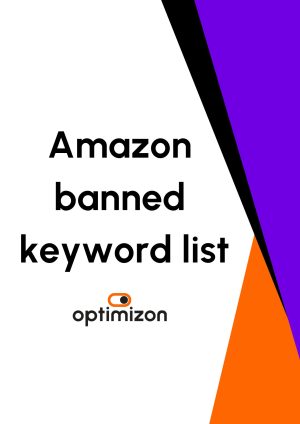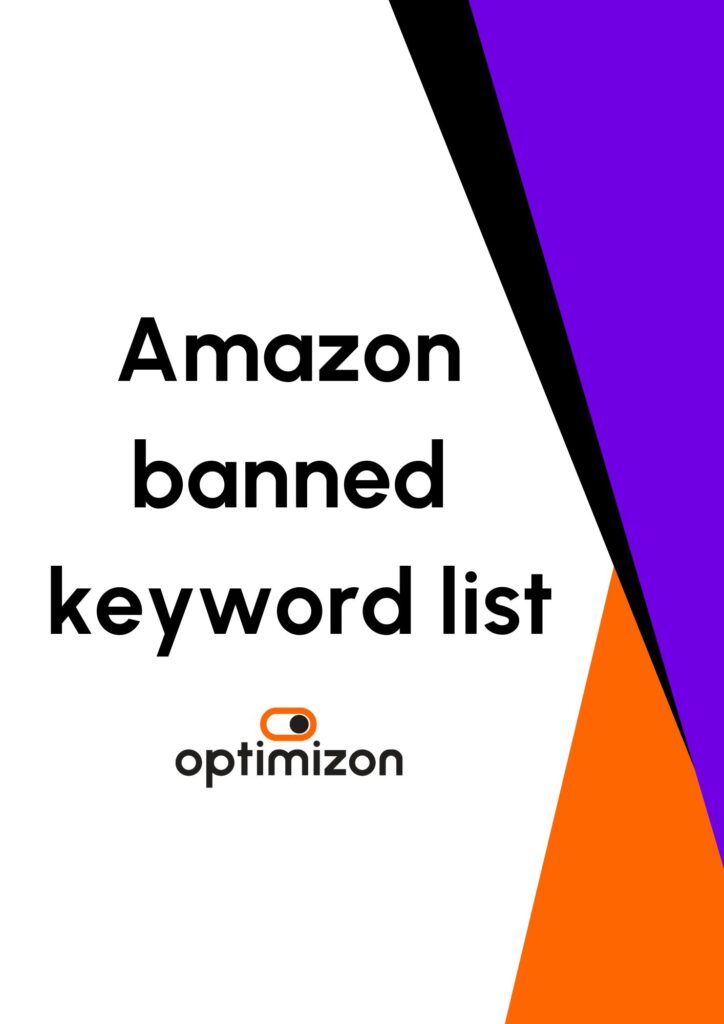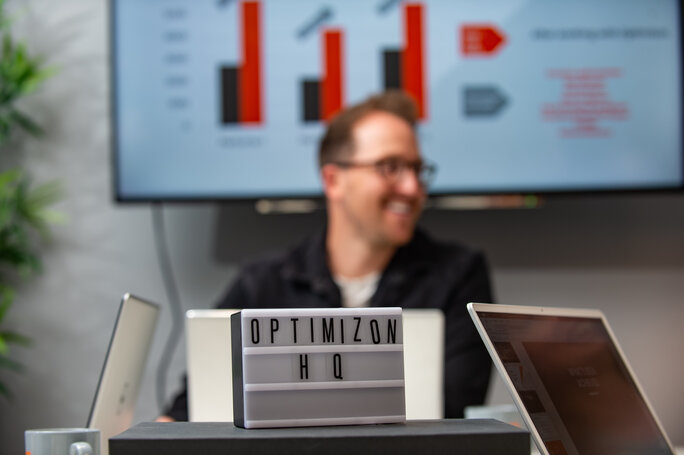You have three selling options on Amazon:
- Amazon Vendor: sell your products in bulk to Amazon (first party or 1P selling)
- Amazon Seller: sell directly to individual customers (third party or 3P selling)
- Hybrid selling: sell your products through Amazon Vendor and Amazon Seller
In January 2023, Amazon announced that to be invited to become a Vendor seller, you need to be turning over at least $1m on a Seller account.
For many businesses, this makes the decision on which option to use simple as Seller is now the default option. However, is it worth aiming to become a Vendor seller?
If you have been offered the opportunity to become a Vendor, you may be wondering how to decide which trading model is right for your business. The bottom line is that it depends. There is no ‘best way’ to sell on Amazon, but choosing the right model for your business will help you get the most bang for your buck. This choice depends on several factors including:
- Your current infrastructure
- The types of products you sell
- Your short-term and long-term business goals
- The level of control you want over your brand on Amazon
It’s a tricky decision that puzzles even the most experienced Amazon sellers. That is why we have put together this handy guide to explain the different characteristics of each selling option.
What are 1P and 3P Selling?
You have probably heard the terms ‘1P sellers’ and ‘3P sellers’ used interchangeably with ‘Amazon Vendors’ and ‘Amazon Sellers’. In a nutshell, all these terms describe your relationship with Amazon:
- Amazon Vendors are first-party (1P) partners that sell their stock directly to Amazon to be resold to customers.
- Amazon Sellers are third-party (3P) partners that use Amazon to sell their products to customers.
The fundamental difference between these relationships is your involvement with end consumers. Businesses that use the hybrid approach sell different items through each channel to maximise profits across their product ranges. We will look at whether this is suitable for your business later in this article
How does Amazon first-party and third-party selling work?
Vendors only interact with Amazon itself. Amazon decides what stock they want to sell and issues you with purchase orders (POs) which you need to fulfil. The amount of stock Amazon orders is determined by a sophisticated algorithm that predicts customer demand. All you need to do as the vendor is to fulfill these purchase orders and Amazon takes care of the rest.
Sounds simple, doesn’t it?
For some companies, it’s ideal. It’s a hands-off approach that allows you to tap into Amazon’s massive customer base without creating a lot of extra work. Order fulfillment can be one of the biggest drains on your time and resources. Letting Amazon handle that side of your business for you is an effective way to reduce operational costs.
The main drawback is you lose control over how your products are sold. Amazon sets the prices of your items using an algorithm to match third-party sellers and external competitors. You may see your brands’ prices drop over time as Amazon and other sellers constantly compete to present the most enticing offer. This is why it is essential any other businesses you sell your products to aren’t inadvertently competing with your brand’s listings on Amazon.
By contrast, if you’re an Amazon 3P Seller, you maintain full ownership of your products right up to the point they reach customers’ doorsteps. You control the price of your products and all listing details, as well as inventory levels and shipping.
As an Amazon Seller you’ll also find it much easier to launch new products and variants. Vendors struggle to do this thanks to Amazon using its purchase-demand algorithm for stock orders, which is based on historical sales for products. It’s not impossible, of course, but it’s worth considering if you plan to significantly expand your product range in the future.
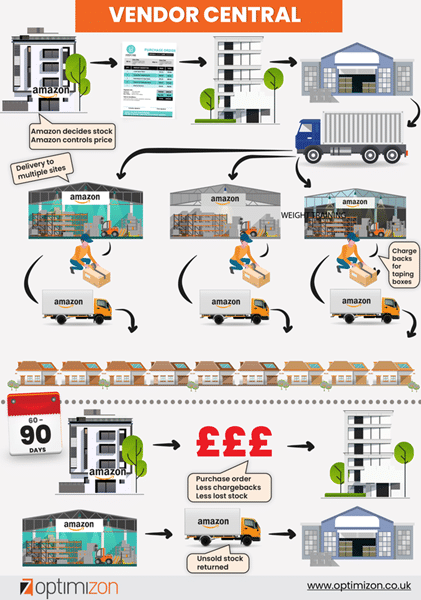
Let’s break down the other key differences between these two trading models.
Access
Anyone can sign up to become a third-party seller on Amazon. Vendor accounts, on the other hand, are much more exclusive.
Amazon’s Vendor program is designed for major brands already turning over $1m on their Amazon Seller account. Consequently, Amazon Vendor is only available to access via invite. Dedicated Amazon vendor recruitment teams around the world seek suppliers they believe will sell a lot on the platform. They look for current Amazon sellers with strong, stable sales records and established brands with high-demand products.
If you’re making plenty of noise and sales in your sector, Amazon is very likely to reach out to you. It also helps if any listings you already have on Amazon convert well and have a low bounce rate. Amazon’s retail team usually contacts potential vendors through email. They have also been known to approach new and exciting brands at trade exhibitions.
Receiving an invitation from Amazon doesn’t necessarily mean first-party selling is the best option for your business. It is ideal for selling products in bulk, but if your products have a lot of variations you may find third-party selling more practical.
Shipping and delivery
One of the biggest differences between the two channels is to whom you ship your products. Vendors simply ship stock to Amazon warehouses. Sellers have the more involved task of getting orders into customers’ hands. You have a couple of options for achieving this.
Fulfilled by Amazon (FBA)
More than two thirds of Amazon Sellers get Amazon to fulfill their orders for them. At first glance, this service looks similar to the first-party trading model. FBA sellers send stock to Amazon warehouses and Amazon picks, packs and ships their customer orders. On closer inspection, however, you’ll quickly see that there are major differences between first-party selling and third-party selling with FBA.
Primarily, Amazon buys stock from Vendors and pays the supplier before it has sold products to customers. Amazon then pays its Vendors every 30, 60 or 90 days depending on their contract.
Meanwhile, Amazon only pays Sellers using FBA when customers buy their products. Sellers receive these payments every two weeks. Amazon also charges FBA Sellers warehouse storage fees and fulfillment fees for every unit sold.
Additional fees mean FBA isn’t necessarily cost-effective for your business, particularly if you sell lots of low-value items. It is, however, a great option for reducing your workload whilst retaining full control over your pricing and brand strategy.
Many businesses take advantage of this service simply because they cannot deliver orders as quickly as Amazon. Customers also get free delivery for items delivered through FBA and listings show the all-important Prime badge. All of these factors play crucial roles in customer satisfaction.
Customers frequently abandon shopping carts due to additional shipping costs and long delivery times. Using FBA and reducing delivery times and shipping costs for your customers can therefore have a significant impact on your sales.
Fulfilled by Merchant (FBM)
Sellers who choose this option take on all responsibilities for warehousing and distributing items. It’s ideal if you already have a strong operational set-up for delivering online orders, as you must be able to deliver speedily – it’s what customers expect when they shop on Amazon. Alternatively, you can outsource the work to a third-party fulfillment service. Regardless of which approach you take, you’re responsible for meeting Amazon’s service requirements.
FBM is generally cheaper than FBA, plus you have greater control over packaging, shipping, and inventory levels. This could be important, for example, if you sell fragile items that need careful handling.
You can still get the Prime badge on your listings by applying for Seller Fulfilled Prime (SFP). To qualify, you will need to commit to delivering orders within two days at no extra cost to the customer. You must deliver 99% of orders on time and adhere to Amazon’s strict return policy. It’s a great way to get all the benefits of the Prime badge without the hidden fees of FBA.
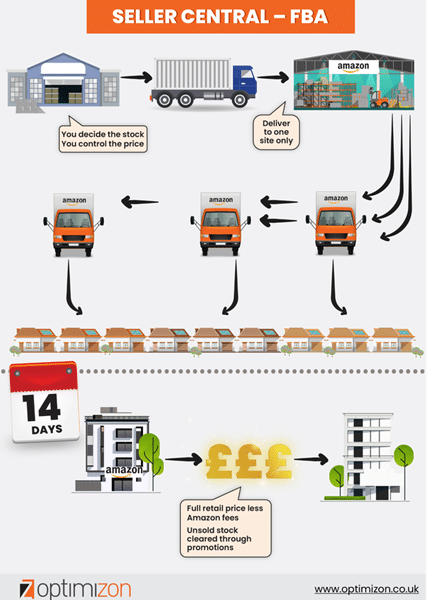
One of the most obvious advantages of first-party selling is bypassing all these considerations entirely. Vendors send out large quantities of stock to one customer: Amazon itself. Purchase Orders are not without their own challenges, however.
Amazon has very strict guidelines for Vendor’s POs and non-compliance results in costly chargeback fees. You can receive charges for a variety of reasons including sending stock too early or too late, packaging issues, or stock discrepancies. You may even receive fees for something as simple as an incorrectly placed sticker.
This still may be preferable, however, compared to dealing with lots of individual customer orders. It boils down to your current infrastructure and whether you have the capacity to handle multiple orders.
Control of your prices on Amazon
One of the major advantages of being an Amazon Seller is maintaining full control over the price of your products. This allows you to adjust your pricing strategy as needed to remain competitive without cutting profits. It also means you can ensure your products are priced consistently across all selling platforms.
Vendors, however, have much less control over price once they have sold their products to Amazon. Amazon frequently adjusts its products’ prices in order to offer the cheapest deal to customers. They may even break your Minimum Advertised Price (MAP) policy to do so. This can create issues with your other resellers and lead to long-term devaluing of your products.
Increasing the wholesale price you sell your products to Amazon can also be tricky, particularly if your competitors have not raised their own prices. This rigidity may mean it becomes unprofitable to continue selling your products directly to Amazon. It may be worthwhile to sell on Amazon Seller to secure your profit, particularly if margins are tight to begin with.
Hybrid Selling
Hybrid or 2P selling can help you get the best of both worlds. Different products suit different models and using both Vendor and Seller can help you increase profits across your product range. The disadvantage, of course, is needing to meet the requirements of both Amazon Vendor and Seller at the same time.
Hybrid selling requires tight management with daily account monitoring, stock and sales analysis. Reporting tools on each channel differ, making reporting on overall sales tricky and time-consuming.
You will also need to be careful not to duplicate products listed in Vendor Central and Seller Central. You can avoid a messy catalogue by separating your products into two categories: one for 1P selling and the other for 3P selling. It can be helpful to identify the reasons for putting each item into each list, both for current and future reference when expanding your range.
It can be well worth investing the extra time and resources in managing two accounts for the increased flexibility you will receive. If you sell a particularly diverse range of products, such as large high-ticket items and small, low-margin items, using one channel exclusively may not be so profitable. If all your products are fairly similar, however, a hybrid approach may be more trouble than it’s worth.
Conclusion
We know how challenging it can be to decide on the best selling model for your business. Many businesses simply need to decide between 1P or 3P selling, but hybrid selling can be hugely beneficial if you have the resources to manage it. Overall, it comes down to how involved you want to be in your Amazon business and what kind of products you sell.
One way to help you make this decision is to commission an audit and review from our Amazon experts. They will look at all aspects of your brand and business model, including issues around Brand Registry and chargebacks, and give you an unbiased view on what would be the best route to follow. If you would like to speak to our specialist global Amazon agency for further guidance, contact our team today.


